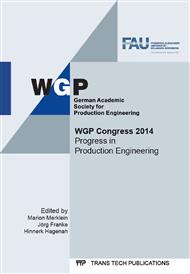p.493
p.501
p.509
p.517
p.525
p.533
p.539
p.547
p.555
Mechanical Properties of Large Three-Dimensional Specimens Build through Direct Powder Deposition
Abstract:
This work presents the results of manufacturing three-dimensional tensile test specimens using widespread hardware usually deployed for laser cladding. Using a laser cladding processing head with coaxial powder feed and a 3-axis-CNC-system macroscopic three-dimensional tensile test specimens have been built by means of additive manufacturing process from cobalt-based Stellite 21 powder on a substrate made of S235JR steel. The additive process has been made by generating a CAD-model of the geometry under investigation and translating it into G-Code using VisCAM RP4.0 software from Marcam Engineering usually used for selective laser melting devices. An interface translating G-Code into program code which is executable by a CNC-system has been developed, additionally the CNC-code has been extended in order to trigger the processing laser. The specimens have been generated under consideration of three different exposure strategies with respect to path orientation in order to investigate their influence on mechanical properties of processed material. After the post-processing by milling and deburring the specimen underwent tensile tests, additionally metallographic investigations and hardness measurements have been done in order to investigate the influence of process parameters on porosity, cracks distribution and hardness of Stellite 21. It has been found that there are connections between process parameters and porosity and cracks of generated samples. Compared with cast material the Young’s Modulus has been found to decrease slightly without significant relation with path orientation, while ultimate tensile strength has been found to be higher than that of cast material, with a significant dependency of the orientation of the laser path. Achieved results show the technical possibility of creating three-dimensional samples by the widespread laser cladding process and hardware. Furthermore, static mechanical properties of generated parts prove to be competitive to as-cast parts in terms of elasticity and ultimate tensile strength.
Info:
Periodical:
Pages:
525-532
Citation:
Online since:
September 2014
Authors:
Price:
Сopyright:
© 2014 Trans Tech Publications Ltd. All Rights Reserved
Share:
Citation:


